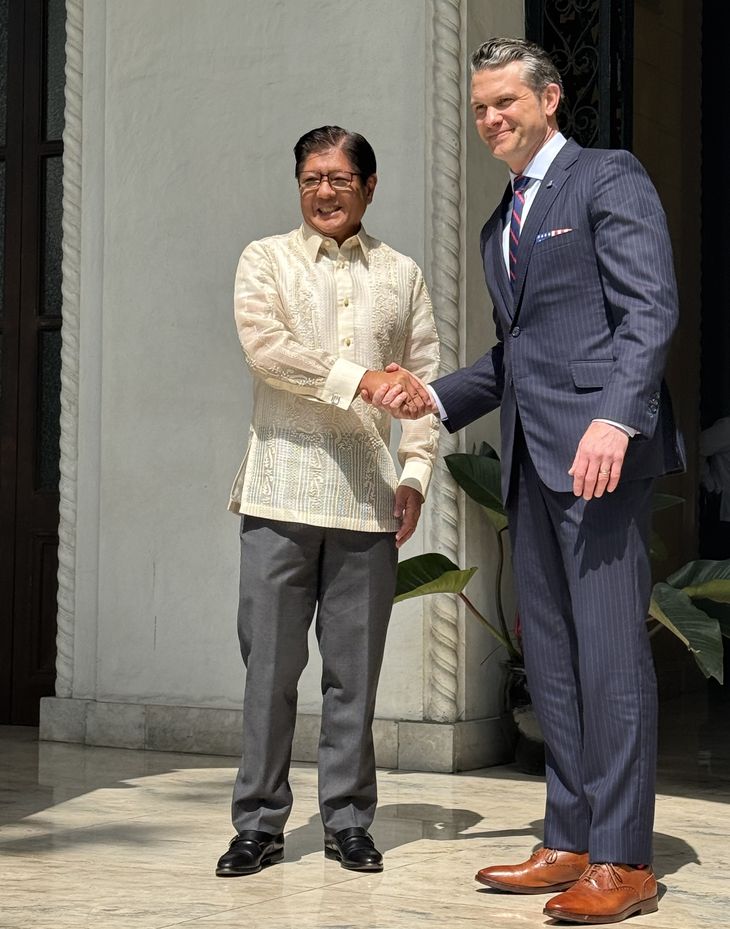
MANILA — The U.S. military is sending a new autonomous missile system and drone sea vessels to the Philippines amid growing tensions between Manila and Beijing in the South China Sea.
Defense Secretary Pete Hegseth announced the planned deployment of the advanced Navy-Marine Expeditionary Ship Interdiction System, called NMESIS, along with what he termed highly capable unmanned surface vessels on Friday.
New weapons and increased military and defense industrial cooperation reflect “the strength of our ironclad alliance, particularly in the face of communist China’s aggression in the region,” Mr. Hegseth said, noting the alliance has never been stronger.
The mobile ground-based anti-ship missile system will be used in the annual Exercise Balikatan joint U.S.-Philippines military drills set to begin next month.
“These systems will enable U.S. forces and the armed forces of the Philippines to train together on using advanced capabilities to defend the Philippines’ sovereignty,” Mr. Hegseth said at a press conference here with Philippines Defense Secretary Gilberto Teodoro.
The NMESIS missiles will further strengthen U.S. missile strike power in the Philippines. In April 2024, the Army’s new Typhon missile, known as the strategic mid-range fires, was deployed in northern Luzon, the Philippines’ largest and most populous island, for military drills and remained in place after the exercises.
A NMESIS missile launcher was shown to reporters during Mr. Hegseth’s visit to a Marine Corps base in Hawaii on Tuesday.
NMESIS anti-ship missiles are precision-guided, sea-skimming cruise missiles with ranges of 100 miles. The military plans to deploy the systems, which can be remotely targeted and fired, at locations around the Pacific for use in a future conflict.
The Typhon is a precision-guided system that can fire both Navy SM-6 missiles and long-range Tomahawk land-attack cruise missiles.
The SM-6 can hit aircraft or ships up to 120 miles away. The Tomahawk has a range of 1,000 miles – enough to hit China from the Philippines.
The Typhon deployment in April 2024 was originally intended to be temporary, but the system remains at the request of the Philippines.
China denounced the Typhon deployment last year and said Manila’s plan to purchase more of the systems constitutes a substantial threat to peace and security.
Mr. Hegseth and Mr. Teodoro agreed to “re-establish deterrence” in the region, and the defense secretary noted the U.S. is providing $500 million in military assistance.
In addition to the new missiles, the alliance partners will seek to improve interoperability of U.S. and Philippine military forces. As part of that effort, special operations commandos from both nations will conduct training on an island in the northernmost part of the Philippines that is a relatively short distance from Taiwan — a major flashpoint in U.S.-China relations.
Mr. Hegseth and Mr. Teodoro also agreed to a new bilateral defense industrial cooperation partnership. The cooperation on defense industry work is a key feature of the Trump administration’s efforts to prod U.S. allies to do more to build up their own defense capabilities.
The new defense industry cooperation will involve joint production of unmanned weapons systems and improved logistics and support capabilities.
To better protect against aggressive Chinese cyberattacks, the two nations also agreed to develop better cyber defenses as part of the alliance.
Improved U.S.-Philippines cyber security will also assist the United States in providing more advanced capabilities and coordinating operations with the Philippines military, according to Mr. Hegseth.
Earlier Friday, Mr. Hegseth met with President Ferdinand Marcos Jr. and other defense and industry leaders. Those discussions, Mr. Hegseth said, are just the beginning of a strengthening of the alliance.
Other allies in the Asia-Pacific region also are being urged to step up their defenses and to improve cooperation with the U.S. military.
The meetings in Manila are part of Mr. Hegseth’s first trip to Asia as defense secretary and highlighted the growing importance of the 1951 mutual defense pact that commits the United States to defending the Philippines from attack.
The next stop on the weeklong visit to the region will be Japan, another key regional ally. Mr. Hegseth arrived at Yokota Air Base north of Tokyo late Friday.
The Pentagon is working to build closer ties with the Philippines in response to recent aggressive operations against Philippine vessels on the part of the Chinese navy and maritime militias in the South China Sea.
China is claiming sovereignty over 90% of the sea, and the Philippines has charged China with violating its sovereignty in disputed islands.
The Pentagon has called the Chinese military operations “gray zone” warfare — conflict below the level of kinetic military action.
In the Spratly islands dispute, the Biden administration took no visible action to support the U.S. treaty ally from Chinese naval bullying that has included firing water cannons and ramming Philippine vessels in the sea.
Asked by The Washington Times if the Trump administration would deploy warships from the Navy’s Seventh Fleet to the South China Sea to provide an enduring naval presence to better protect the Philippines, Mr. Hegseth sidestepped.
Mr. Hegseth said his Pentagon is working to rectify “many years of deferred maintenance” for U.S. military forces under the Biden administration that resulted in military “weakness.”
While the Biden administration’s talk of strengthening security in the region seemed to produce few if any results, Mr. Hegseth vowed the Trump administration “will deliver” stronger defense capabilities.
“It’s not my job to determine where the Seventh Fleet goes,” Mr. Hegseth said. “I defer to [Indo-Pacific commander] Adm. [Sam] Paparo and his war plans — real war plans.”
Mr. Hegseth came under fire this week from critics, mainly congressional Democrats and liberal media outlets, for disclosing sensitive information on a group chat about U.S. airstrikes on Houthi rebels.
The defense secretary earlier this week denied that the chat group that inadvertently included an Atlantic magazine reporter involved any classified information or even sensitive information about military operations.
Mr. Hegseth said Adm. Paparo understands clearly the situation of Chinese gray zone operations in the South China Sea and is working with partners in the region “to make sure we are leaning forward in our [military] posture.”
The U.S., he said, will work in partnership with the Philippines, Japan, South Korea, Australia and other allies to improve deterrence in an effort to avoid war.
“Not waiting for events to develop. Not retrograding to place [forces] further from the front, but deploying capabilities forward, and creating dynamics and strategic dilemmas for the communist Chinese that help them reconsider whether or not violence or action is something they want to undertake,” Mr. Hegseth said.
Mr. Hegseth said his message during his meetings in the region is that the United States wants peace. “But in order to bring that peace, we will be strong.”
Mr. Teodoro, the Filipino defense secretary, said his country will increase its cooperation not only with the U.S. military but with other regional allies.
Training on the NMESIS missile and other high-tech weapons will increase the lethality of the Philippines military and bolster efforts to improve overall defense capabilities, he said.
The Chinese Communist Party presents the most significant threat to the Philippines’ national security, he said.
“We are facing a problem now of the overreach of the Communist Party of China,” Mr. Teodoro said.
Freedom of navigation, rule of international law and individual freedoms are at stake in the confrontation with China, he said.
“We must be prepared to answer and to meet and even to deter enemy possibilities in the future for our mutual defense, and in defense of freedom and international law,” he said.
China’s military criticized the Hegseth visit to the Philippines.
People’s Liberation Army Sr. Col. Wu Qian, a spokesman for the Defense Ministry, told reporters in Beijing that U.S.-Philippine military cooperation must not undermine other nations’ security or peace and stability.
“By the way, looking at history, the U.S. has an astonishing record of breaking promises and betraying allies,” Col. Wu said.
“We always oppose interference by countries outside the region when it comes to the South China Sea issue,” he said.
The Chinese military will take all necessary measures to defend national interests and safeguard peace and stability in the region, Col. Wu said.








